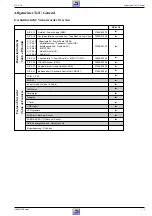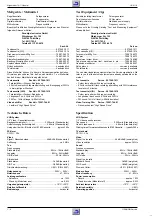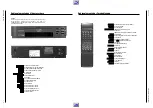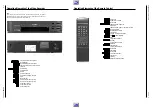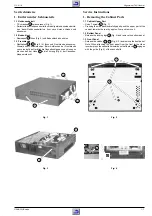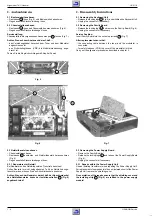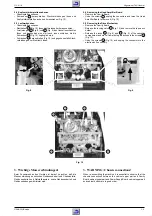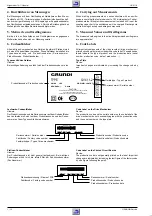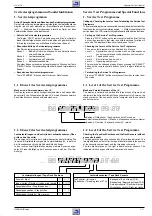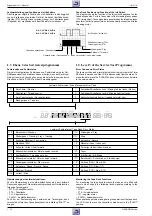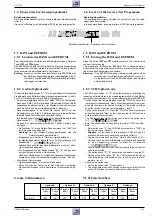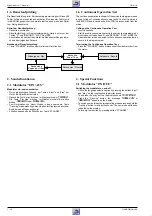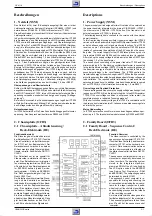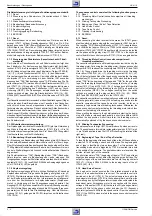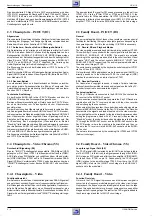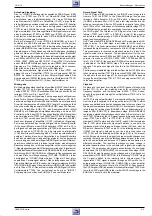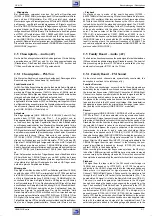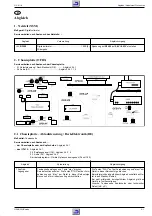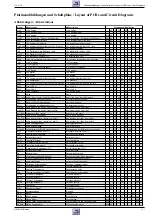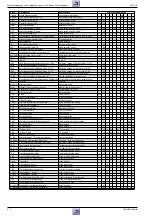
GRUNDIG Service
2 - 3
GV 411-2
Beschreibungen / Descriptions
On IC7410-(30) the
µ
C feeds out a pulse-width-modulated square-
wave signal (REEL) containing information on the speed and the
phase. This signal is fed via the plug contact 1915-(6) to the headwheel
motor driver IC7301 located in the head amplifier board and is used as
a control voltage.
2.1.6 Tape Servo Control
The capstan motor is a three-phase motor which is fitted with Hall
generators. These generate signals which are fed to the capstan motor
driver IC (LB1887) on the capstan motor assembly via the pins 8…13.
Depending upon these signals the IC commutates the individual
phases of the capstan motor.
Switching over of the sense of rotation (CREV) is carried out via pin 26
of the LB1887. For this the
µ
C (IC7410) feeds out from pin 8 a LOW
level for the forward sense of rotation or a HIGH level for the reverse
direction. This control signal is passed through R3403 and plug contact
1913-(4) to the capstan motor driver. The pulses (FG) from the capstan
motor driver IC (LB1887) pin 3 for speed control are fed via plug contact
1913-(2), IC7411-(8), to the internal comparator and IC7411-(11) to
IC7410-(19). The tachopulses (actual value) are compared in the
IC7410 with an internally generated reference value. From IC7410-(31)
the
µ
C feeds out a pulse-width-modulated square wave voltage (CAP).
This is integrated by R3448 / C2419 and fed via plug contact 1913-(3)
as a control voltage to the capstan motor driver IC (LB1887).
2.1.7 Tracking / Autotracking
During recording, encoded 25Hz-CTL-pulses are recorded onto the
tape via the sync head. These pulses are required on playback for
tracking control.
On recording, the 25Hz pulses are taken from IC7410-(22) to
IC7411-(16) and are then passed through IC7411-(2) and the connec-
tor 1918-(1) to the sync head.
On playback, the recorded CTL pulses are scanned by the sync head
to be subsequently converted to square wave pulses in IC7411 and
passed on via IC7411-(16) to IC7410-(20).
When a cassette is loaded, the Autotracking function determines the
optimum track position on playing back. For this, a voltage "TRIV" or
"TRIA" (Tracking Information Video or Audio) is derived from the
envelope of the FM packages and fed in to the main computer IC7410
on the analog inputs (pin 56 or 55). This voltage is generated in the
head amplifier or in the audio circuit stage.
On the basis of the tracking centre position, the nominal tracking value
is increased or reduced. For each of the two directions, an appropriate
nominal value is determined at which the voltage derived from the FM
envelope "TRIV" or "TRIA" starts to decrease as against the maximum
determined voltage level. The mid-value between the two limit values
is then used as the optimum tracking value. On completion of this
measurement, the autotracking function is switched off and the deter-
mined phase is controlled by the CTL pulses.
If more than two successive CTL pulses are missing, the autotracking
function is reactivated assuming, in this case, that a new recording with
a different tracking position is played back.
2.1.8 EEPROM
In the EEPROM (IC7412) the control computer (IC7101) stores special
data of the customer and the machine (eg. option code, station tuning
data/channels, software/adjustment values). The data is transferred
via the I
2
C-bus (SDA / SCL).
An IC7410-(30) gibt der
µ
C ein impulsbreitenmoduliertes Rechteck-
signal (REEL) aus, das sowohl Drehzahl- als auch Phaseninformationen
enthält. Dieses wird über Steckerkontakt 1915-(6) dem Kopfscheiben-
motortreiber IC7301 auf der Kopfverstärkerplatte als Regelspannung
zugeführt.
2.1.6 Bandservoregelung
Der Capstanmotor ist ein Dreiphasenmotor, der mit Hallgeneratoren
bestückt ist. Diese erzeugen Signale, die dem Capstanmotor-Treiber-
IC (LB1887) auf der Capstanmotor-Einheit über die Pins 8…13 zuge-
führt werden. Abhängig von diesen Signalen erfolgt in diesem die
Kommutierung der einzelnen Phasen des Capstanmotors.
Die Drehrichtungsumschaltung (CREV) erfolgt über den Pin 26 des
LB1887. Dazu gibt der
µ
C (IC7410) an Pin 8 für die Drehrichtung
vorwärts LOW-Pegel bzw. rückwärts HIGH-Pegel aus. Dieses Steuer-
signal wird über R3403 und den Steckerkontakt 1913-(4) dem Cap-
stanmotor-Treiber zugeführt. Die Impulse (FG) vom Capstanmotor-
Treiber-IC (LB1887) Pin 3 für die Drehzahlregelung werden über
Steckerkontakt 1913-(2), IC7411-(8), dem internen Komparator und
IC7411-(11) dem IC7410-(19) zugeführt. Die Tachoimpulse (Istwert)
werden im IC7410 mit einem intern erzeugten Sollwert verglichen.
Über IC7410-(31) gibt der
µ
C eine impulsbreitenmodulierte Rechteck-
spannung (CAP) aus. Diese wird mit R3448 / C2419 integriert und über
Steckerkontakt 1913-(3) als Regelspannung dem Capstanmotor-Trei-
ber-IC (LB1887) zugeführt.
2.1.7 Trackingregelung / Autotracking
Während der Aufnahme werden über den Synchronkopf codierte
25Hz-CTL-Impulse auf das Band aufgezeichnet, die bei Wiedergabe
zur Spurnachführung benötigt werden.
Diese 25Hz-Impulse gelangen bei Aufnahme von IC7410-(22) zum
IC7411-(16) und von hier über IC7411-(2) und die Steckverbindung
1918-(1) an den Synchronkopf.
Bei Wiedergabe werden die aufgesprochenen CTL-Impulse vom
Synchronkopf abgetastet, im IC7411 in Rechteckimpulse umgeformt
und über IC7411-(16) dem IC7410-(20) zugeführt.
Nach dem Einlegen einer Cassette wird bei Wiedergabe mit Hilfe der
Autotracking-Funktion die optimale Spurlage ermittelt. Zu diesem Zweck
führt man dem Ablaufrechner IC7410 über die Analogeingänge (Pin 56
bzw. Pin 55) eine von der Hüllkurve der FM-Pakete abgeleitete Span-
nung "TRIV" bzw. "TRIA" (Trackinginformation Video bzw. Audio) zu.
Diese werden im Kopfverstärker bzw. Audio-Schaltungsteil erzeugt.
Ausgehend von der Tracking-Mittellage wird der Tracking-Sollwert
vergrößert und verkleinert. Für jede der beiden Richtungen wird nun
der zugehörige Sollwert ermittelt, bei dem die von der FM-Hüllkurve
"TRIV bzw. TRIA" abgeleitete Spannung gegenüber dem maximal
ermittelten Spannungswert abzunehmen beginnt. Als optimaler Trak-
kingwert wird der Mittelwert zwischen den beiden Eckwerten einge-
stellt. Nach Abschluß dieser Messung wird die Autotracking-Funktion
abgeschaltet und die ermittelte Phasenlage über die CTL-Impulse
geregelt.
Fehlen mehr als zwei aufeinanderfolgende CTL-Impulse, wird das
Autotracking erneut gestartet. Es wird in diesem Fall davon ausgegan-
gen, daß eine neue Aufnahme mit anderer Trackinglage vorliegt.
2.1.8 EEPROM
Im EEPROM (IC7412) speichert der Bedienrechner (IC7101) kunden-
und gerätespezifische Daten (z.B. Optionscode, Sendereinstellungen-
Kanäle, Software-Abgleichwerte). Die Datenübertragung erfolgt über
den I
2
C-Bus (SDA / SCL).
2.2 Chassisplatte – Empfangseinheit (FV)
Signalverarbeitung
Die Empfangseinheit hat die Aufgabe, das vom Tuner kommende ZF-
Signal zu verstärken und zu demodulieren. Es entstehen dabei das
FBAS-Signal und das Audio-Signal.
Vom Kontakt 17 des Tuners 1701 kommend durchläuft das ZF-Signal
das Oberflächenwellenfilter F1722, das die ZF-Durchlaßkurve be-
stimmt. Über IC7201-(1), -(2) führt man es einem regelbaren Breit-
bandverstärker mit Synchrondemodulator und danach einem Video-
verstärker zu. Des weiteren erzeugt man in diesem IC die Regelspan-
nung für den Breitbandverstärker und den Tuner. Diese Regelspannung
gelangt über IC7201-(12) zum Tuner (Kontakt 5). Ihr Regeleinsatz ist
mit R3742 (AGC) einstellbar. Das demodulierte ZF-Signal durchläuft
zwischen Pin 13 und Pin 14 des IC7720 einen Ton-Trap F1740, wo
man den Tonanteil im FBAS-Signal absenkt. Anschließend wird es
verstärkt und über IC7201-(7) sowie der Verstärkerstufe T7721 dem
"IN/OUT"-Schaltungsteil (als "VFV"-Signal) zugeführt.
2.2 Family Board – Frontend (FV)
Signal Processing
The Frontend has the function of amplifying and demodulating the IF
signal fed in from the tuner. The resulting signals are the CCVS signal
and the audio signal.
Coming from the tuner contact 1701-(17), the IF signal passes through
the surface acoustic wave filter F1722, which determines the IF band
pass. Via IC7201-(1), -(2), the signal is fed to a gain controlled
wideband amplifier with synchronous demodulator, and subsequently,
to a video amplifier. Another stage in the IC is used to generate the
control voltage for the wideband amplifier and the tuner. This control
voltage is fed from IC7201-(12) to the tuner (contact 5). The control
threshold level is adjustable with R3742 (AGC). Between pin 13 and
pin 14 of the IC7720, the demodulated IF signal passes through a
sound trap F1740, in which the audio component of the CCVS signal
is attenuated. Subsequently, the signal is amplified and passed on to
the "IN/OUT" circuit stage (as a "VFV"-signal) via IC7201-(7) and the
amplifier T7721.

